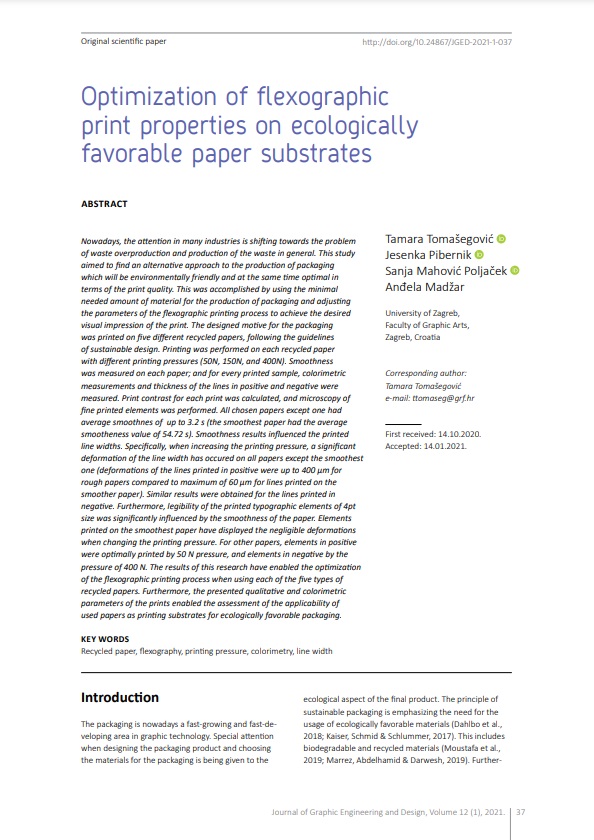Optimization of flexographic print properties on ecologically favorable paper substrates

Published 2021-03-01
abstract views: 410 // Full text article (PDF): 252
Keywords
- Recycled paper,
- flexography,
- printing pressure,
- colorimetry,
- line width
How to Cite
Copyright (c) 2021 © 2021 Authors. Published by the University of Novi Sad, Faculty of Technical Sciences, Department of Graphic Engineering and Design. This article is an open access article distributed under the terms and conditions of the Creative Commons Attribution license 3.0 Serbia.

This work is licensed under a Creative Commons Attribution 3.0 Unported License.
Abstract
Nowadays, the attention in many industries is shifting towards the problem of waste overproduction and production of the waste in general. This study aimed to find an alternative approach to the production of packaging which will be environmentally friendly and at the same time optimal in terms of the print quality. This was accomplished by using the minimal needed amount of material for the production of packaging and adjusting the parameters of the flexographic printing process to achieve the desired visual impression of the print. The designed motive for the packaging was printed on five different recycled papers, following the guidelines of sustainable design. Printing was performed on each recycled paper with different printing pressures (50N, 150N, and 400N). Smoothness was measured on each paper; and for every printed sample, colorimetric measurements and thickness of the lines in positive and negative were measured. Print contrast for each print was calculated, and microscopy of fine printed elements was performed. All chosen papers except one had average smoothnes of up to 3.2 s (the smoothest paper had the average smootheness value of 54.72 s). Smoothness results influenced the printed line widths. Specifically, when increasing the printing pressure, a significant deformation of the line width has occured on all papers except the smoothest one (deformations of the lines printed in positive were up to 400 μm for rough papers compared to maximum of 60 μm for lines printed on the smoother paper). Similar results were obtained for the lines printed in negative. Furthermore, legibility of the printed typographic elements of 4pt size was significantly influenced by the smoothness of the paper. Elements printed on the smoothest paper have displayed the negligible deformations when changing the printing pressure. For other papers, elements in positive were optimally printed by 50 N pressure, and elements in negative by the pressure of 400 N. The results of this research have enabled the optimization of the flexographic printing process when using each of the five types of recycled papers. Furthermore, the presented qualitative and colorimetric parameters of the prints enabled the assessment of the applicability of used papers as printing substrates for ecologically favorable packaging.
Article history: Received (October 14, 2020); Revised (January 9, 2021); Accepted (January 14, 2021); Published online (March 1, 2021)

